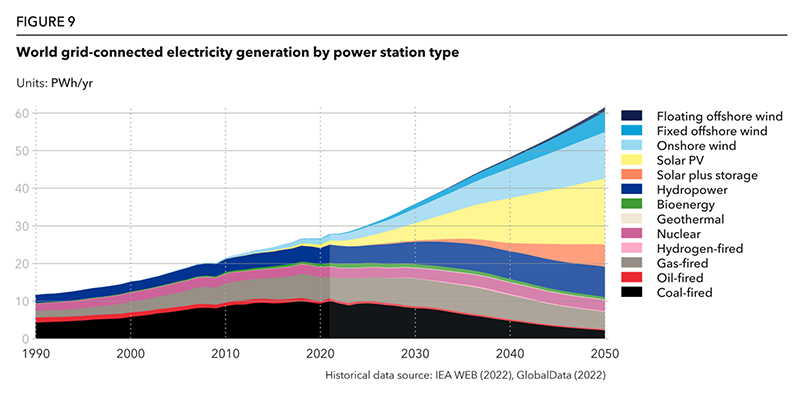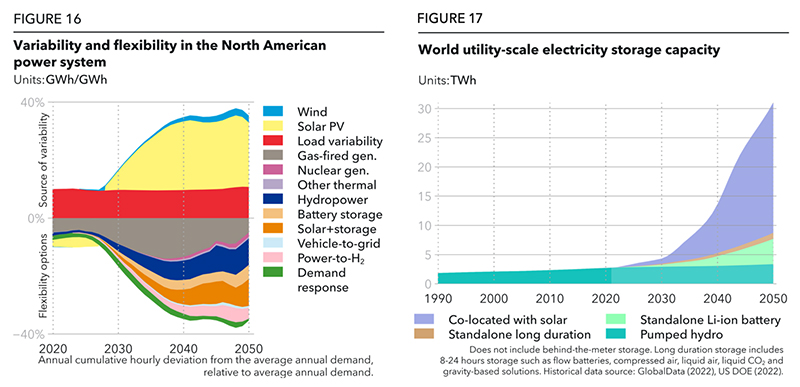|

July
1, 2023
By
Zachary Shahan
Solar Will Reach Dominance As Cheapest Source Of
Electricity In World
DNV, a major global risk management company, has
come to the common conclusion that solar PV power will get so cheap
that it will eventually dominate new electricity capacity and
production. “In 2050, solar PV will be in unassailable position as the
cheapest source of new electricity globally,” the company stated in
its annual global energy report. Naturally, some would say that this
will happen well before 2050, and is already starting to happen, but
the “unassailable” part is on the way still.
To put that word into numbers, DNV expects coal to have 4% of the
market by then and fossil gas to have 8% market share. And that’s
regarding electricity generation! DNV’s not talking about new power
installation capacity with those figures. By 2050, DNV expects 70% of
the world’s electricity to be coming from variable renewables (wind
and solar) and expects fossil fuels to account for just 10% of
electricity production.

Chart courtesy of DNV.
How much does solar power have to grow, in terms
of capacity, to reach that level of dominance in the electricity
market? DNV predicts it will grow 24 times over compared to the 2020
solar PV total.
DNV points out that new solar power installations reached 1 gigawatt (GW)
in 2004, then reached 10 GW six years later in 2010, then reached 100
GW nine years later in 2019, then — despite everything going on in the
world — reached 150 GW in 2021. DNV sees the market getting up to 550
GW a year by 2050.
“From 2030 onwards, we expect annual additions of between 300 and 500
GW. By mid-century, total installed capacity will be 9.5 TW for solar
PV and 5 TW for solar + storage. The resulting 14.5 TW of solar
capacity is 24 times greater than in 2020.”
Naturally, the growth of solar PV will be driven by drops in solar PV
costs. “We expect the average LCOE of solar PV to fall by at least 40%
by 2050, with individual projects falling by as much as 60% relative
to today’s average cost. With its high cost-learning rates (26% at
module level per doubling of capacity, declining to 17% in 2050),
solar PV will be the cheapest source of new electricity globally by a
considerable margin, despite its lower capacity factors relative to
other VRES sources. By 2050, 23 PWh/yr of solar electricity will be
generated worldwide.”
Solar is expected to account for 30% of on-grid global electricity
production by 2050, on the back of 54% of the world’s power capacity.

Chart courtesy of DNV.
Furthermore, solar PV will get a big boost from
the cost drops and growth of battery energy storage. DNV expects
battery energy storage costs to drop 80% by 2050, based on a 19%
cost-learning curve. Here’s the rest of DNV’s short summary of the
topic: “Storage: pumped hydro currently provides most of today’s power
system storage, but will only contribute marginally in the future.
Batteries will provide most of the enormous future storage needs
(Figure 17), either as standalone or in solar+storage or
vehicle-to-grid configurations. From 2020 to 2050, standalone
utility-scale storage will grow from 2.7 TWh to 8.8 TWh, more than
doubling in size. Of this, Li-ion battery storage capacity will see
the largest growth, from almost nothing to 4.4 TWh by mid-century.
Towards the end of this decade, solid-state batteries appear to offer
the best potential for a next wave in performance and cost
improvements. Alternative chemistries will also evolve to satisfy the
growing demand for longer-duration storage (5+ hours).”
Those are DNV’s thoughts on where the world on-grid electricity
market, solar power, and storage will be by 2050.
Green Play Ammonia™, Yielder® NFuel Energy.
Spokane, Washington. 99212
www.exactrix.com
509 995 1879 cell, Pacific.
Nathan1@greenplayammonia.com
exactrix@exactrix.com
|